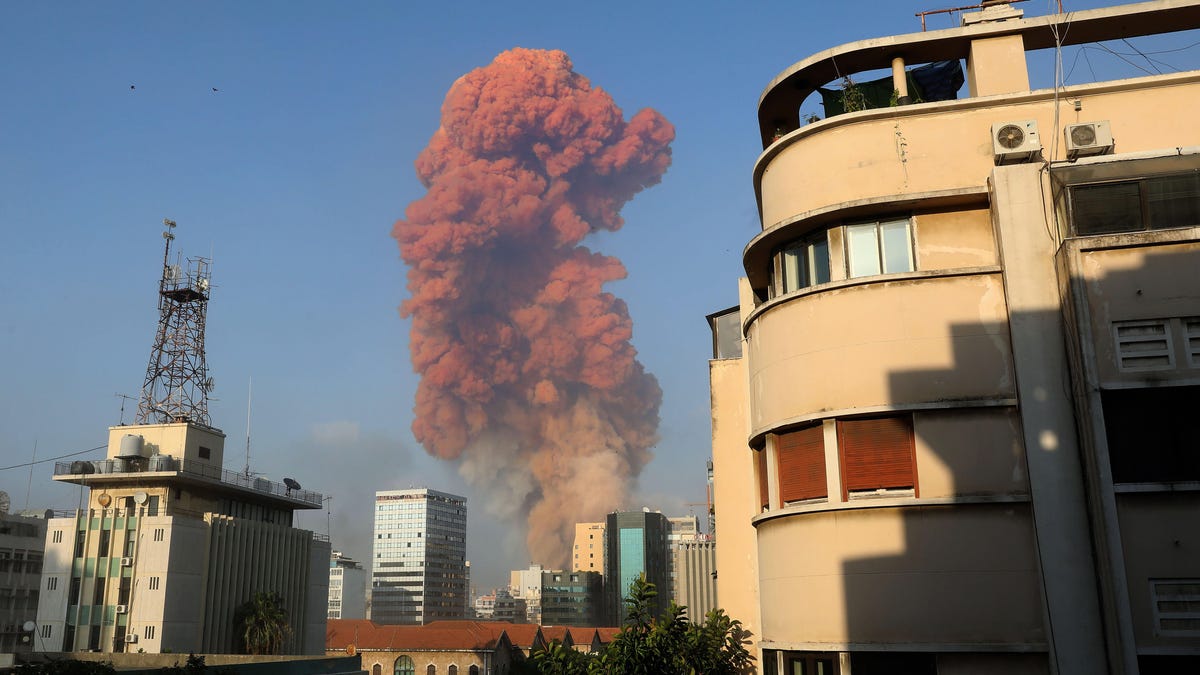Beirut explosion: How ammonium nitrate caused deadly blast in Lebanon
A large stockpile of ammonium nitrate is believed to have caused the explosion in the Port of Beirut.

An explosion at a warehouse in the Port of Beirut on Tuesday killed more than 100 people and left more than 4,000 people injured. In the aftermath of the blast, videos show plumes of red-brown smoke and the apocalyptic extent of the destruction, with buildings leveled for miles. According to a report by Al Jazeera, Lebanon Prime Minister Hassan Diab said the explosion was fueled by a stockpile of over 2,700 tons of ammonium nitrate, confiscated and stored for approximately six years at the port.
The explosive potential of ammonium nitrate is well understood and has been used in numerous terrorist attacks including the Oklahoma City bombing of 1995. So what is ammonium nitrate, why is it explosive and why do we use it?
Ammonium nitrate is a chemical compound containing the element nitrogen (as well as hydrogen and oxygen) and is commonly used in agriculture as fertilizer. Plants rely on photosynthesis, converting sunlight to energy using chlorophyll. Nitrogen is an essential element for this process and ammonium nitrate is particularly good, compared with other fertilizers, at delivering plants nutrients.
It's also an explosive compound and is used around the world in mining and construction operations requiring detonations. Under normal conditions, the chemical is highly stable. It can explode after exposure to contaminants or fuel oil and then heated, which sets off a cascade of reactions.
When heated to above 170 degrees Fahrenheit, ammonium nitrate begins to undergo decomposition. But with rapid heating or detonation, a chemical reaction can occur that converts ammonium nitrate to nitrogen and oxygen gas and water vapor. The products of the reaction are harmless -- they're found in our atmosphere -- but the process releases huge amounts of energy.
"The idea in making any sort of explosive is to go from a high energy compound to a low energy one," explains Ian Rae, a professor at the University of Melbourne. "The energy given out is what you get as explosive power."
This also requires pressure to build up in a confined space, without being able to dissipate. Burning ammonium nitrate in an open field, for instance, isn't likely to result in an explosion, Rae said.
Additionally, in the explosion, not all of the ammonium nitrate is used up and exploded. Some of it decomposes slowly creating toxic gases like nitrogen oxides. It's these gases that are responsible for the red-brown plume of smoke seen in the aftermath of the Beirut explosion, Rae said.
Another angle on the Beirut harbor explosions — this one from the sea pic.twitter.com/U2k2zTi3Ew
— Borzou Daragahi 🖊🗒 (@borzou) August 4, 2020
After the fireball erupts in the video above, you can immediately see the shock wave expanding away from the blast. Moisture in the air is quickly condensed, forming a white sphere around the explosion zone. It's not clear what else may have been ignited or exploded in the blast -- or what was stored at the docks -- but Prime Minister Diab is expected to make this information known "soon," according to The Guardian.
Because of ammonium nitrate's explosive potential, countries and unions impose strict regulations on how to store and process it. "It is generally kept under controlled conditions and modified volumes to minimize chances of explosion," says Brent Kaiser, a plant biologist at the University of Sydney. In Australia, the storage and use of ammonium nitrate is monitored to prevent these types of explosions occurring, Kaiser said.
Read also: Beirut explosion devastation revealed through sobering satellite views
The US Environmental Protection Agency, in conjunction with the Occupational Safety and Health Administration and the Bureau of Alcohol, Tobacco, Firearms, and Explosives lists a number of statutes and regulations involved in the manufacturing, processing and storage of ammonium nitrate. Facilities holding high quantities of the chemical are subject to inspection by the Department of Homeland Security. The US cybersecurity and infrastructure security agency has also proposed a program to closely regulate the sale of transfer of ammonium nitrate.
The accidental detonation of ammonium nitrate has resulted in a number of accidents in the last century. In 2015, explosions partly caused by the detonation of around 800 tons of ammonium nitrate rocked the Beijing port of Tianjin, killing 173 people.
An explosion of ammonium nitrate was responsible for the worst industrial accident in US history in 1947. A ship in the harbor of Texas City, Texas, carrying approximately 2,300 tons of ammonium nitrate caught fire, supposedly via a discarded cigarette, causing a series of explosions that killed 581 people.
Two explosions are said to have rocked the port. Though the causative agent of the larger, second explosion appears to be ammonium nitrate, the full scale of the devastation in Lebanon isn't yet completely understood and an investigation will be performed. "What happened today will not come to pass without accountability," Diab said. He has also announced that Wednesday will be a national day of mourning in the country and the port and surrounding region has been declared a disaster zone.
"This is clearly a very significant explosion, and the reported number of deaths is likely to be far higher than currently identified," said David Caldicott, a senior clinical lecturer in medicine at the Australian National University.

